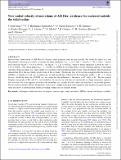Files in this item
New radial velocity observations of AH Her : Evidence for material outside the tidal radius
Item metadata
| dc.contributor.author | Echevarriá, J. | |
| dc.contributor.author | Hernández Santisteban, J. V. | |
| dc.contributor.author | Segura Montero, O. | |
| dc.contributor.author | Ramírez, S. H. | |
| dc.contributor.author | Ruelas-Mayorga, A. | |
| dc.contributor.author | Sánchez, L. J. | |
| dc.contributor.author | Michel, R. | |
| dc.contributor.author | Costero, R. | |
| dc.contributor.author | González-Buitrago, D. H. | |
| dc.contributor.author | Olivares, J. | |
| dc.date.accessioned | 2021-02-26T12:30:12Z | |
| dc.date.available | 2021-02-26T12:30:12Z | |
| dc.date.issued | 2021-02-01 | |
| dc.identifier | 272953082 | |
| dc.identifier | b799723f-6187-4e58-bb72-6f1546441488 | |
| dc.identifier | 85100416791 | |
| dc.identifier | 000608474800047 | |
| dc.identifier.citation | Echevarriá , J , Hernández Santisteban , J V , Segura Montero , O , Ramírez , S H , Ruelas-Mayorga , A , Sánchez , L J , Michel , R , Costero , R , González-Buitrago , D H & Olivares , J 2021 , ' New radial velocity observations of AH Her : Evidence for material outside the tidal radius ' , Monthly Notices of the Royal Astronomical Society , vol. 501 , no. 1 , pp. 596-605 . https://doi.org/10.1093/mnras/staa3615 | en |
| dc.identifier.issn | 0035-8711 | |
| dc.identifier.other | ORCID: /0000-0002-6733-5556/work/89178815 | |
| dc.identifier.uri | https://hdl.handle.net/10023/21515 | |
| dc.description | The authors acknowledge financial support prom PAPIIT project IN114917. JER acknowledges support from a ‘Leids Kerkhoven-Bosscha Fonds’ (LKBF) travel grant to visit the API at UvA. LJS and ARM would like to thank DGAPA, UNAM for financial support provided by Programa de Apoyo a Proyecto de Investigacion e Inovacion Tecnologica (PAPIIT) projects IN102517andIN102617. JVHS acknowledges support from an STFC grant ST/R000824/1. | en |
| dc.description.abstract | Spectroscopic observations of AH Herculis during a deep quiescent state are put forward. We found the object in a rare long minima, allowing us to derive accurately the semi-amplitudes: K1 =121 ± 4 km s-1 and K2 = 152 ± 2 km s-1 and its mass functions MWsin 3i = 0.30 ± 0.01 M⊙ and MRsin 3i = 0.24 ± 0.02 M⊙, while its binary separation is given by asin i = 1.39 ± 0.02 R⊙. The orbital period Porb = 0.25812 ± 0.00032 d was found from a power spectrum analysis of the radial velocities of the secondary star. These values are consistent with those determined by Horne, Wade & Szkody. Our observations indicate that K5 is the most likely spectral type of the secondary. We discuss why we favour the assumption that the donor in AH Her is a slightly evolved star, in which case we find that the best solution for the inclination yields i = 48° ± 2°. None the less, should the donor be a ZAMS star, we obtain that the inclination is between i = 43° and i = 44°. We also present Doppler tomography of H α and H β, and found that the emission in both lines is concentrated in a large asymmetric region at low velocities, but at an opposite position to the secondary star, outside the tidal radius and therefore at an unstable position. We also analyse the H α and H β line profiles, which show a single broad peak and compare it with the previous quiescent state study that shows a double-peaked profile, providing evidence for its transient nature. | |
| dc.format.extent | 10 | |
| dc.format.extent | 3280186 | |
| dc.language.iso | eng | |
| dc.relation.ispartof | Monthly Notices of the Royal Astronomical Society | en |
| dc.subject | Techniques: radial velocities | en |
| dc.subject | Techniques: spectroscopic | en |
| dc.subject | Stars: individual: AH Her | en |
| dc.subject | Novae | en |
| dc.subject | Cataclysmic variables | en |
| dc.subject | QB Astronomy | en |
| dc.subject | QC Physics | en |
| dc.subject | Space and Planetary Science | en |
| dc.subject | Astronomy and Astrophysics | en |
| dc.subject | NDAS | en |
| dc.subject | MCC | en |
| dc.subject.lcc | QB | en |
| dc.subject.lcc | QC | en |
| dc.title | New radial velocity observations of AH Her : Evidence for material outside the tidal radius | en |
| dc.type | Journal article | en |
| dc.contributor.institution | University of St Andrews. School of Physics and Astronomy | en |
| dc.identifier.doi | 10.1093/mnras/staa3615 | |
| dc.description.status | Peer reviewed | en |
| dc.identifier.url | https://arxiv.org/abs/2011.08310 | en |
This item appears in the following Collection(s)
Items in the St Andrews Research Repository are protected by copyright, with all rights reserved, unless otherwise indicated.

